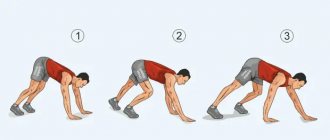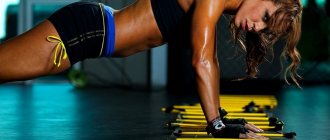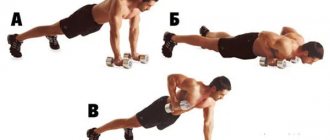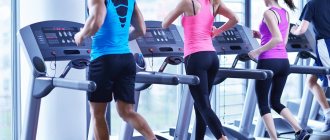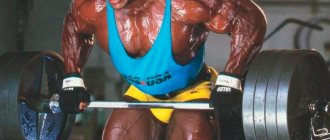Take your strength to the next level with these kettlebell workout routines.
If you're short on time (as most of us are), then choose a kettlebell on your next trip to the gym. Why? Kettlebell lifting is both a cardio workout and a strength workout. According to a recent study, subjects who performed kettlebell exercises (16 kg on average) for four weeks increased their tissue oxygen consumption rate index (VO2), which is a reliable indicator of cardiovascular health, by 6%. system and which the body can effectively use during high-intensity training
In the same study, subjects who did circuit training for the same amount of time did not increase their VO2. At the same time, a number of other studies confirm that training with kettlebells effectively increases strength and has a greater impact on muscles than jumping squats.
The beauty of training with kettlebells – when done correctly – is their versatility. “Just one subject, but so many exercise options: from high-intensity fat-burning workouts with kettlebells to low-rep strength training. They are great for developing hip strength without the risk of injury that occurs with deadlifts.”
We have prepared five programs for you that will help you understand how to properly train with kettlebells.
- Supersets for quick results
- Five exercises to gain muscle mass or burn fat
- Five best abdominal exercises
- Circuit training for strength
- Advanced workout using two kettlebells.
But before we move on to the exercises, let's decide on the choice of equipment.
How to choose a quality kettlebell
- Pro Standard “I love professional kettlebells (see picture above) because they are the same size regardless of the weight,” explains Turner. “It’s useful when doing difficult exercises.”
- Cast Iron “I prefer cast iron to rubber. It seems to me that they are more stable. This allows you to efficiently perform exercises such as kettlebell wrist rows, when you need to move the weight of your entire body on them.”
- Ideal weight “For men, I would recommend a weight of 16-20 kilograms. They’re heavy enough to challenge your muscles and get a kettlebell pump, but light enough to allow for high-intensity exercises and high reps.”
What is power and what does it look like?
Strength can be divided into 2 types:
- Maximum strength - peak strength level. Usually defined by lifting the maximum weight for 1 repetition.
- Strength endurance is the ability to produce close to maximum force with minimal loss of performance.
It is very important to separate these concepts. Because the training for each of these points will be completely different. Looking ahead a little, I’ll say right away that for a weightlifter, the second point is more important - strength endurance .
One very important thing to remember is that maximal strength does not necessarily lead to improved strength endurance . Of course, if an athlete training maximum strength squats 150 kg for 1 rep, then 80 kg will not be a problem for him, and he can freely squat this weight 20 times. But maybe there is another athlete who built his training differently and has a repeated maximum in the squat 120kg, but 80kg squats 40 times. Strength endurance is not necessarily dictated by percentage of maximum strength.
For example, MSMK in kettlebell lifting Dmitry Davydik performs 8 repetitions with a working weight of 120 kg, and squats 100 times in one approach with a weight of 82.5 kg. Here is a living example of a high level of strength endurance.
A set of exercises with kettlebells for all muscle groups
The beauty of kettlebell training programs is that the dynamic, natural movements help you get the benefits of both a fat-burning cardio workout and a heavy-weight, muscle-building workout at the same time. To make the training most effective, we have collected the exercises into supersets.
How to perform
Perform one set of ten repetitions of the first exercise in a superset, and then immediately ten repetitions of the second exercise. Rest for 60 seconds and repeat. In total, you need to perform four supersets. Rest for two minutes and move on to the next superset. For exercises on one side, perform exercises on one side in the first set, and then on the other. To progress the load, add one repetition to each set until you reach 15, then increase the weight and start again with 10 repetitions.
Why does it work
Is it possible to pump up with kettlebells using this training program? Undoubtedly. This program includes three supersets, which are a pair of exercises performed one after another without a break. In the first superset, the emphasis is on the chest, back and core muscles. In the second, we work the abs in a standing position, and in the third, in a horizontal position. The result is an increased heart rate, which allows you to effectively burn fat and build big, strong abdominal muscles.
Approximate weight
Ideally, you should use a 16kg kettlebell for the first two supersets and a 12kg kettlebell for the last.
Superset 1. Compound Advantage
Work your entire upper body with just two exercises.
1A. Floor press
Lie on the floor, holding a weight in each hand at chest level. Straighten one arm and push upward, lifting your shoulder off the floor and twisting your torso. Having lowered one arm, straighten the other using the same principle. Alternately repeat the arm press in a relaxed ri, explains Turner. “I encourage my clients to “slam” their lower back into the floor. This helps prevent arching in the lower back and disabling of the abdominal muscles.”
1B. Kettlebell wrist row
Get into a plank position with straight arms and weights. Pull one up, moving your elbow back toward your hips. Lower the weight, repeat with the other hand. Keep your core tight and keep your hips still.
Tip: “This is a great core and back exercise that helps increase stability and therefore core strength,” explains Turner. “To make the exercise more challenging, bring your feet together as close as possible.”
Superset 2. Dynamic Strength
Use your core muscles to stay in position.
2A. "Mill"
Starting position: standing straight, holding the weight in an outstretched arm above your head, feet wider than shoulder-width apart. The weight distribution should be biased towards the hand that holds the weight. While looking at the weight, lower your body down until your other hand touches the floor.
Tip: The Windmill exercise looks intimidating, but it's worth doing for core strength and shoulder stability. This exercise is also a great stretch for the hamstrings.”
2B. "Eight"
Bring the weight back between your legs, moving it from one hand to the other. Swing the kettlebell back and forth with one hand, then repeat the movement with the other. Try to keep your movements as smooth as possible.
Tip: “This is a great exercise for core training because the specific movement requires that the abdominal muscles be constantly tense, which allows you to effectively maintain balance.”
Superset 3: Core Benefits
Finish your workout with exercises that burn your abdominal muscles.
3A. Curl Press
Holding two weights above your head, sit on the floor with your knees bent. Slowly lower yourself to the floor, moving the projectile towards your chest. Tighten your abdominal muscles to rise to the starting position and push your arms up.
Advice: “While sitting straight, tighten your pelvis, and when you lower yourself, twist your back, trying to touch the floor with each vertebra in turn. The slower you move, the harder your abdominal muscles work.”
3B. Moving the weights in the plank
Stand in a plank position with your arms straight, your body in a straight line from the top of your head to your heels, and place a kettlebell on your right side. Move your left arm under your body, grab the kettlebell and move it to your left side. Switch hands and repeat the movement.
You can perform each set of exercises with weights at home or in the gym, the results will not change depending on where you train.
Advice : “A good way to diversify the bar. The further away from your body you place the kettlebell, the more difficult the exercise becomes. To make the exercise even more difficult, you can slightly lift the apparatus off the floor.”
A short introduction about various qualities and comprehensive development
All sports require combinations of different qualities - strength, speed, endurance, etc. Peak performance is a game of balance, and every sport has its “ideal athlete,” including kettlebell lifting.
Indeed, increasing aerobic capacity can improve a strength athlete's recovery, increasing the strength limit will increase the performance threshold of an endurance athlete, not to mention the benefits for all-round development.
Five of the Best Kettlebell Abdominal Exercises
Bodyweight exercises are great for building core abdominal strength. But if you want to get rock-hard abs with clearly defined six-pack abs, then you need to add weights to your workout. One effective way is weights.
We have already talked about the most effective abdominal exercises and want to expand the list with movements with additional weight.
“I use kettlebells because they are versatile. They allow you to perform both basic exercises and exercises for all muscle groups, they are suitable for both beginners and professionals, they can be used both in the gym and at home,” explains Ashton Turner, co-founder of a fitness club in London, strength-building specialist. “Exercising on one side disrupts balance by forcing the body to use more muscle to stay in place. Any movement behind the head, such as the Windmill, also requires core engagement in addition to balance.”
How to perform
Do three sets of ten reps, resting 45 seconds between sets, 90 between exercises. To increase the load, add one repetition per set to each workout until you reach 15. Then move on to heavier weights, while starting again with ten repetitions.
Why does it work
These exercises help you develop your anti-rotation abilities, which helps you stand stronger on your feet. Also, this training program will allow you to achieve rock-hard abs and effectively work out your oblique abdominal muscles and lower back.
Kettlebell bench press
Lie on the floor, holding a weight in each hand at chest level. Straighten one arm and push the kettlebell upward, lifting your shoulder off the floor and twisting your torso. Having lowered one arm, straighten the other using the same principle.
Tip: “By lying on the floor, you increase core stability, thereby reducing the risk of injury,” explains Turner. “I encourage my clients to “slam” their lower back into the floor. This helps prevent arching in the lower back and disabling of the abdominal muscles.”
Mill
Starting position: standing straight, holding the weight in an outstretched arm above your head, feet wider than shoulder-width apart. The weight distribution should be biased towards the hand that holds the weight. While looking at the weight, lower your body down until your other hand touches the floor.
Tip: The Windmill exercise looks intimidating, but it's worth doing for core strength and shoulder stability. This exercise is also a great stretch for the hamstrings.”
Lateral press
Starting position: kettlebell at shoulder level. Tighten your core and lower your body to the side while straightening your arm. Try to keep the kettlebell as still as possible, instead move your body. Having reached the bottom point, return to the starting position.
Tip: “A great exercise for the obliques because you need to maintain balance while pressing the kettlebell away from your core. The lower you go, the greater the intensity of the exercise and the center of gravity shifts.”
Curl Press
Holding two weights above your head, sit on the floor with your knees bent. Slowly lower yourself to the floor, moving the weights toward your chest. Tighten your abdominal muscles to rise to the starting position and push your arms up.
Advice: “While sitting straight, tighten your pelvis, and when you lower yourself, twist your back, trying to touch the floor with each vertebra in turn. The slower you move, the harder your abdominal muscles work.”
Moving the weights in the plank
Stand in a plank position with your arms straight, your body in a straight line from the top of your head to your heels, and place a kettlebell on your right side. Move your left arm under your body, grab the kettlebell and move it to your left side. Switch hands and repeat the movement.
Advice: “A good way to diversify the bar. The further away from your body you place the kettlebell, the more difficult the exercise becomes. To make the exercise even more challenging, you can lift the weight slightly off the floor.”
Video review of the 10,000 kettlebell swing program
I propose to organize a small competition and try to complete this training program, and after completing it, leave your feedback in the comments under the article. Let's check this complex together and form our opinion about this training program based on our own experience!? I'm waiting for your opinion!
And also read: American kettlebell swings - what is the essence of the technique? Russian kettlebell swings: how to do it correctly? Kettlebell push in a long cycle - what is the point of the exercise?
Circuit training with kettlebells for strength
“The goal of this kettlebell circuit is to increase strength,” explains London-based Evolve 353 trainer Ashton Turner. “It’s a great workout for athletic development, but it’s much easier on technique than the Olympic bench press. The selected exercises also translate into other types of load, such as running and jumping. They also allow you to develop strength, focusing on the back muscles. This means it's a great workout for rugby and football players."
How to perform
You can do both circuits and a finishing exercise, or, if you are short on time, one of two circuits and a finishing exercise. During circuit training, all exercises are performed in a circle, one set each, without rest. Record the time in which you manage to complete the circle and try to reduce it by at least a couple of seconds with each workout - this is a great motivation and way to track progress.
Circuit training 1
Perform one set of each exercise in order. Rest 60 seconds between circuits. Eight laps in total.
1A. Swing a kettlebell with one hand
Reps: 8-12 on each side
Stand straight with your feet slightly wider than shoulder-width apart. Brace your core, squeeze your shoulder blades together, and swing the kettlebell back between your legs to begin the swing. When you feel a stretch in your hamstrings and glutes, drive your hips forward, swinging the kettlebell in front of you. Squeeze your glutes as much as possible and lift the weight to shoulder level.
Advice: “The exercise develops a good sense of balance. When performing one-arm kettlebell swings, you should engage your core and obliques as much as possible to prevent your core from twisting.”
1B. One-arm kettlebell snatch
Reps: 8-12 on each side
Start by swinging the kettlebell with one hand, but once it's between your legs, shrug your shoulders back and up to keep the kettlebell as close to your body as possible. Raise your elbow to drive the kettlebell upward. When it is level with your elbow, rotate your arm under the weight and push upward until the kettlebell is level above your head.
Tip: “This exercise is great for building strength because it works multiple muscle groups at once and requires extra effort to complete the movement. It also helps increase the strength and stability of the shoulder joint.”
1C. Moving the weights in the plank
Reps: 16-24 per side
Start in a plank position with your arms outstretched and place a kettlebell on your right side. Keep your hips tucked and your core engaged throughout the exercise. Move your left arm under your body and grasp the kettlebell. Move it to the other side, making sure that your hips remain straight. Lower and repeat with the other hand.
Advice: “One of the main conditions for working on strength in this exercise is tense core muscles. This exercise teaches you how to control your core muscles and also develops your sense of balance.”
Circuit training 2
Perform one set of each exercise in order. Rest 60 seconds between circuits. Eight laps in total.
2A. Swings with two kettlebells
Reps: 8-12 on each side
Stand straight, feet slightly wider than shoulder-width apart, and hold a kettlebell of the same weight in each hand. Brace your core, squeeze your shoulder blades together, and push the weights back between your legs to begin the swing. When you feel a stretch in your hamstrings and glutes, drive your hips forward, swinging the kettlebells in front of you. Squeeze your glutes as much as possible and lift the weights to shoulder level.
Tip: “By performing double kettlebell swings, you increase the weight used, which allows you to work more effectively on strength.”
2B. Two kettlebell push
Reps: 8-12 on each side
Start as if you were doing kettlebell swings. Once they reach abdominal height, extend your elbows back and lift your arms under and around the kettlebell to get into a kettlebell-on-chest position, then lower them between your legs and repeat the movement.
Tip: “This is an explosive strength-building exercise.”
2C. Carpal thrust
Reps: 8-12 on each side
Get into a plank position with straight arms and weights. Place your feet a little wider than usual for greater stability, and tighten your core and glutes. Pull one kettlebell upward, moving your elbow back toward your hips and squeezing your shoulder blades together. Shift your body weight to your other hand. Lower the weight, repeat with the other hand. Keep your core tight and keep your hips still.
Tip “This is a great core and back exercise that helps increase the stability, and therefore strength, of your core muscles. To make the exercise more difficult, bring your feet together as close as possible.”
Final exercise
3. Swing with two hands
Time: 60 seconds
Do as many two-arm swings as possible in one minute, then rest for a minute. Record your best result and try to improve it with each subsequent workout. However, the main focus should be on the technique of performing the exercise, and not on the number of repetitions. Just 8-10 approaches.
Standing still is a step backwards
Serious tests are vitally necessary for a person. We only grow when we push boundaries, achieve goals and break personal records. We do everything better, we look great and enjoy life.
In everyday life, we either progress or regress. There is no “maintenance” phase. Moderation in training quickly turns into stagnation. And in general, moderation is for the weak. Therefore, if we want to improve, we must look for new challenges, fight and win.
The training program “10,000 kettlebell swings” is just such a test, or, as it is now fashionable to say, a challenge. And it can significantly improve your physical condition in just four weeks.
A set of exercises with two kettlebells for double results
Once you've mastered the beginner exercises and learned how to properly perform basic kettlebell exercises such as swings, presses, and cleans, you can move on to more advanced exercises. “Using two kettlebells is an advanced level of challenge because the exercise requires a strong sense of balance and muscle control,” explains London-based Evolve 353 trainer Ashton Turner. “Besides, two 16-kilogram weights seem lighter than one 32-kilogram weight.”
How to perform
Do three sets of ten repetitions, rest for 45 seconds between sets, and 90 between exercises. The second exercise involves alternately pressing the kettlebell upwards for each repetition. To increase the load, add one rep per set to each workout until you reach 15. Then move to heavier kettlebells, starting again with ten reps.
Why does it work
By using two weights instead of one, you are not breaking any rules. It doesn't matter whether you use one kettlebell or two, the load increases the same. The main thing is to make sure that you perform the exercise equally with both hands, otherwise you risk serious injury to the shoulder joint.
Swings with two kettlebells
Swing the kettlebell between your legs until you are in a neutral position (this activates your glutes). Try to keep your wrists as close to your hips as possible. At the top, tighten your gluteal muscles to reduce the load on your lower back.
Tip: “Place your feet a little wider than when performing the same exercise, but with one kettlebell. This will give you enough room for both kettlebells, and you'll be able to target your hips, glutes, and hamstrings more effectively."
Kettlebell press
Stand upright in a kettlebell-on-chest position, then perform a deep squat. Alternately perform the kettlebell press from behind your head, looking in the direction of movement of the projectile.
Tip: “Great test for the hips and thoracic spine, as well as shoulder stability.”
Snatch with two kettlebells
Swing the weights between your legs while pushing your hips forward. When they are just below chest height, bring your elbows back and lift your arms under and around the weights, using the resulting momentum to bring the weights straight above your head.
Tip: “Try to avoid placing your hands under the weights and do not perform the press as a separate movement. The exercise should be performed in one smooth movement. Two kettlebells greatly increase the difficulty and effectiveness of the exercise because you need to perform the same motion with both shoulder joints.”
Push with two kettlebells
Swing the weights between your legs while pushing your hips forward. Once they reach abdominal height, extend your elbows back and lift your arms under and around the weights to get into a kettlebell-on-chest position, then lower them between your legs and repeat the movement.
Tip: “Make sure not to move the weights too far away from your body as this will put more strain on your back muscles.”
Double overhead press
Get into a kettlebell chest position, holding the weights at shoulder height with your elbows tucked to your side for extra support. Push the weights straight up overhead, using the most efficient path to reduce stress on the shoulder joint.
Tip: “Make sure both elbows are directly under the weight during the push and that the weight is directly above your shoulders as you complete the rep.”
Source: https://www.coachmag.co.uk/kettlebell-workouts/5764/5-kettlebell-workouts-for-strength-cardio-and-fat-loss
Classes after 40 years
Read also: Exercises for weight loss at home for women: 4 complexes with PHOTO
Most people who begin to get involved in this equipment are less than 35 years old. However, there are also those who want to get in shape after 40 years. If they have been practicing before, they will not have any problems.
If you have no experience, it is better to start with several training sets that are guaranteed to lead to the desired result without harm to health.
Circuit training
The most effective type of training. It consists of cyclically repeating certain exercises with added weight. You should choose from swings, squats, turns and bends.
You need to train at a fast pace. You should rest no more than 60 seconds between circles.
Such loads perfectly burn fat and train endurance. Three laps to start with is ideal. Gradually the circles should be increased.
